by Tom Gaylord
Writing as B.B. Pelletier
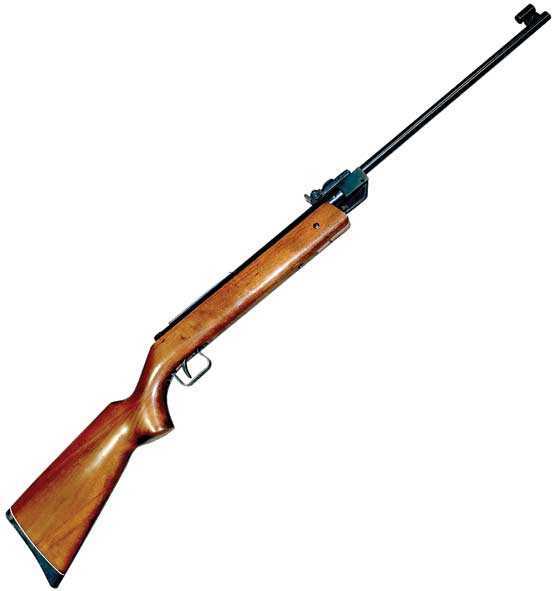
Diana 27S.
This report covers:
- Carel
- Diana 27S
- Anti-beartrap
- Description
- Dimensions
- Sights
- Ball bearing sear
- History
- Parts interchange
- Summary
This report is one I wanted to write months ago, but after all I wrote about reader Michael’s Winchester 427 and my own Diana 26 and Diana 35, I thought I had better let vintage Dianas rest for awhile.
Carel
I purchased this Diana 27S along with the Diana 26 and Diana 35 I have just mentioned from reader Carel of the Netherlands. He gave me a fantastic deal on three air rifles that are quite uncommon in the US. The 35 is the most common of the three, but Carel had a very early one that was different than the one many Americans have seen, so it was just as uncommon to me as the other two.
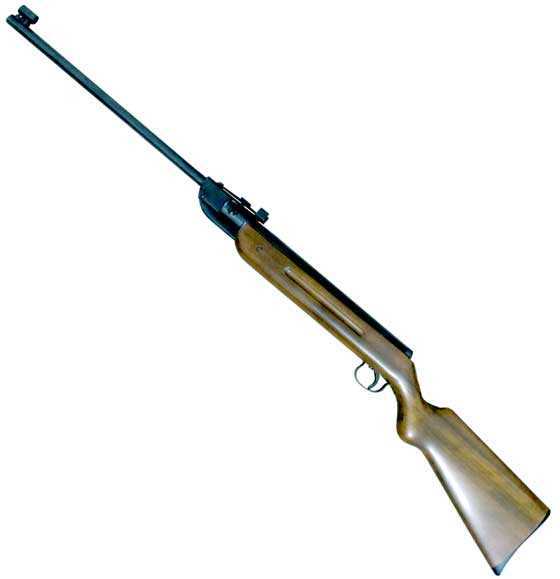
The Diana 35 I got from Carel is a very early one that we don’t often see in the U.S.
I was able to tune the 35 to be a smooth shooter and an easy cocker — something that you don’t see with run-of-the-mill Diana 35s (and Winchester 435s/Hy-Score 809s/Beeman 200s that are all the same rebranded models). That was a 6-part series that’s linked above.
Diana 27S
And now we come to the subject air rifle — the .177-caliber Diana 27S. What is it? Well, there is very little written about this model so I’m going to expand your horizon just a tad. There are some subtle refinements on this scarce Diana model.
In the UK the German Diana is called the Original Diana, because the Milbro company of Scotland received the rights to produce and sell Diana airguns as war reparations following WWII. In the 1981 edition of The Airgun Book, author John Walter says the Original Diana 27S comes with “an automatic trigger-blocking safety”. I thought, “Oh, no — not one of those!” But don’t fret. He didn’t mean what you think.
Anti-beartrap
What Walter meant was the 27S has an anti-beartrap device built into it, unlike the standard model 27 that you can close when it’s broken open by pulling the trigger (restrain the barrel when doing this!). There is no separate safety lever on the 27S. But the barrel has to be closed in order for the trigger to work, so Walter is correct in what he says, but the term anti-beartrap is used more commonly for this feature today. We will take a closer look at the parts that support this function when we go inside the rifle. Yes, we will be going inside!
Description
The Diana 27S is a conventional breakbarrel spring-piston air rifle, but it differs from the 27 in a couple obvious ways. The triggerguard is very angular The forearm is also squared off and the end is cut on an angle instead of being rounded like the forearm end of a standard 27. The butt has a thin rubber pad that’s separated from the wood by a white line spacer. On a conventional model 27 there is just a red rubber button at the top of the wooden butt to help the rifle stand on its butt without slipping.
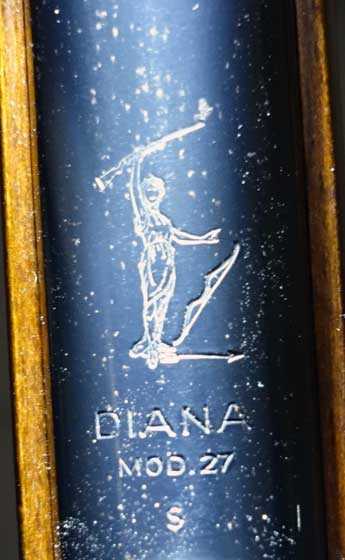
The Diana logo shows Diana dropping her bow for a rifle. As you can see, there are flecks of rust in the blue. Ballistol and 0000 steel wool will handle them.
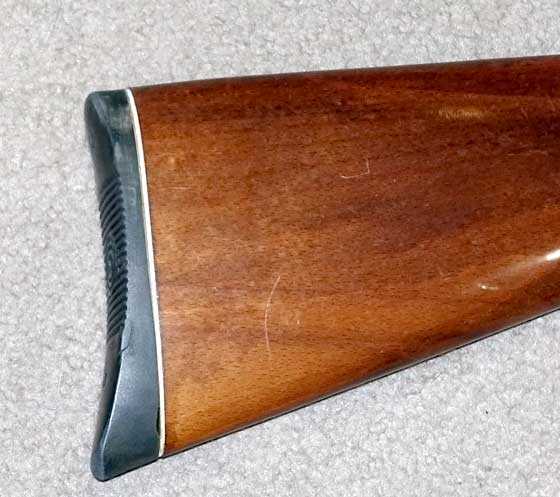
The 27S has a whole butt pad, where the 27 just has a rubber button.
My .177-caliber 27S rifle weighs 6 pounds 10 oz., which is one pound one ounce heavier than my .22-caliber Diana 27 (Hy-Score 807). The .177 caliber adds a little weight because the barrel, having thicker walls, weighs a little more. Also the forearm of the stock is a trifle wider and the cocking slot is shorter because the two-piece cocking link is articulated and therefore doesn’t need the longer slot. More wood means more weight. In theory this makes the stock stiffer, which should help to reduce vibration a little, but in this day of Tune in a Tube, spring gun vibration is a thing of the past.
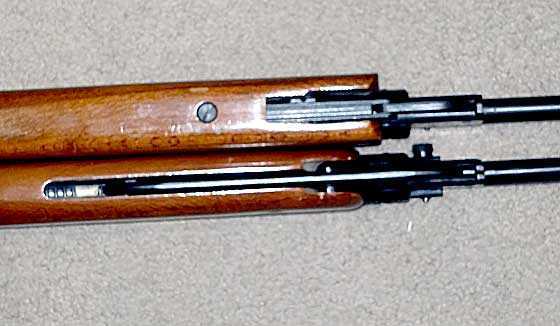
As you can see, the 27S (top) has a much shorter cocking slot than the 27 shown below. You can also see that the forearm is slightly thicker.
Dimensions
The 27S measures 42.25-inches overall. The barrel is just under 18 inches. The pull measures bang-on 13-inches.
Sights
The sights on this rifle are similar to those found on the 27. The front sight is a globe with a fixed tapered post and looks exactly the same as the front sight of a 27. The rear sight adjusts in both directions, but is mostly metal instead of the earlier plastic sight found on the 27. It is the sight that is often called the upgraded all-metal rear sight. And although I have never noticed, later model 27s may also have a rear sight like this.
This sight is a good change because the plastic sights used to break all the time. I think the plastic becomes more brittle with time.
There is also a raised base for a peep sight. It’s tack-welded to the spring tube. Some may think of it as a scope base, but its real purpose is to accept the Diana peep sight that’s made for many of their sporting air rifles.
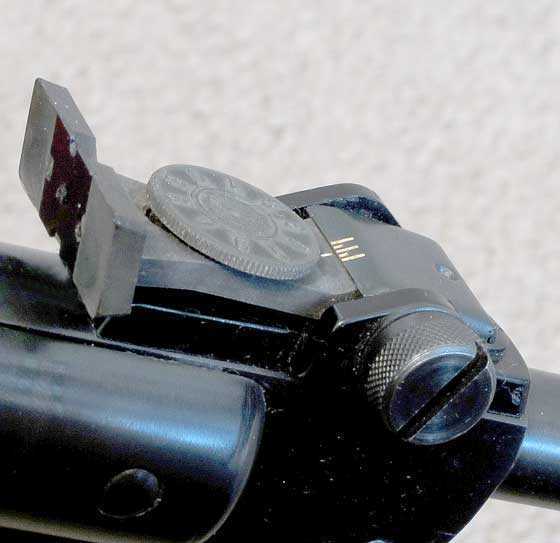
The Diana 27 rear sight is mostly plastic.
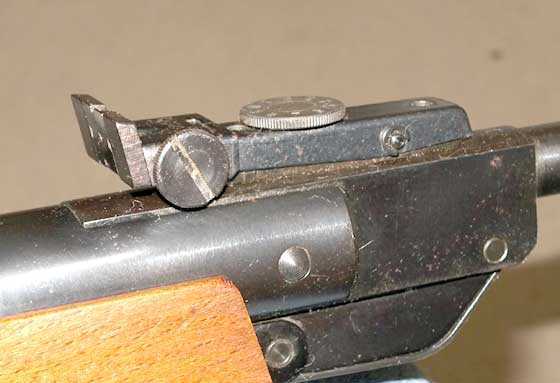
The Diana 27S rear sight is mostly steel.
Ball bearing sear
This rifle has the ball bearing sear. When we go inside we will see how the anti-beartrap device interacts with it.
History
It’s easy to get confused in researching the Diana model 27 because there were several versions of a 27 before World War II. However, those rifles are entirely different and their parts do not interchange with the post-war rifles we are discussing.
The biggest functional difference between the straight 27 post-war model and the 27S is that anti-beartrap device. The biggest obvious differences are the two-piece articulated cocking link and the square triggerguard.
The post-war Diana 27 began production in 1951. The 27S started in 1973. According to Walter, the 27S was pricy. I have no other data to support that, but assuming he is right and the 22-year head start the 27 had it’s no wonder there aren’t as many 27S rifles around.
Parts interchange
The Blue Book of Airguns currently goes out of its way to tell you that, “The model 27L, 27A, 27E, 27S and 27 air rifles appear somewhat similar but they are completely unrelated with virtually no common parts.” Well — that’s just wrong! If you really study the listings (pp. 390 and 391) you will discover that sentence that is repeated several time refers to the PRE WAR model 27s, only! Somebody got trigger-happy with the cut-and-paste function and goofed-up the entry. Several of us are now editing the Blue Book for the next edition and I plan to fix this entry.
The model 27 and 27S rifles that I am writing about today are very similar and share a lot of common parts. The anti-beartrap is one big difference and the articulated cocking link, the stock and the rear sight are the others, though the rear sight may have been used on 27s built after 1973. Until I get inside and see what’s there that’s all I can say.
Summary
So, what do we have in the Diana 27S? I think I can sum it up quickly. It’s an updated model 27. Diana continued producing the 27 until 1987 and the 27S was probably officially terminated at the same time, though a lower sales volume probably ended production somewhat earlier. That’s just my guess, because there is very little solid data on the model.
My plan is to conduct the conventional tests with the rifle and then strip it down and see what lies beneath. It currently buzzes when it fires. As long as I can make it better, why not?

B.B.,
What is the length of pull off this rifle? I’m getting the impression that this was meant as an adult sized rifle rather than a starter rifle like the 27.
Siraniko
Siraniko,
The pull measures 13 inches. So it’s short for an adult and long for a kid.
B.B.
B.B.,
It’s for kidults! ;^)
Michael
BB,
I so like the utilitarian design and function of these early Dianas. They are as close to form follows function as can be. I never cared much for the wooden, slotted butt stock though. Almost every one that I saw did not have the rubber button and the butt was usually rather beaten up.
B.B.
Yippee, we get History Friday and now History Monday!
You can never get to much history…
-Y
BB ,
Be curious to see if the gun has a leather seal . TIAT might slow down the piston , I have used standard lithium on the piston and TIAT on the guide before on lower powered guns . Those ball bearing triggers were used in allot of Diana guns . Nice to see the vintage guns , as things get more and more plastic fantastic.
Gene
With you on the lithium.
B B,
I’ve always thought it slightly strange that the regular 25, 27, 35 continued to be produced alongside the S/ Super series. I wonder if the Supers were intended as replacements for the regular models, initially, but the idea didn’t seem to capture the imagination of the buying public.
Stranger still is the idea that the older models continued on after the new 24-34 range were introduced. So in theory you could choose between say a new 27, 27S, 26 or 28 in the mid 80’s.
Of all the Super series, the 35 is the most common over here in the UK. Its unusual to see one dated after 1982 though. I haven’t seen a 27S being offered for sale for many years but I always keep an eye out!
Im looking forward to further reports as you get to grips with the 27S.
Regards,
Drew
Drew,
I should have mentioned that the S seems to have meant “Super.” At least it did in the UK. That’s what I see in Walter’s books. I have no Diana literature from this time.
I agree that I like the 27 over the S because of its lighter weight and slimmer stock. Maybe that was a common public reaction, though Walter does say it was pricey.
B.B.
Guys, ya’ gotta stop with the steel wool to remove rust. Brass wool is softer than the steel (doesn’t remove the bluing), but harder then the rust, so the rust comes off just as well with brass wool and Ballistol as it would with steel wool…and, without the damage to the bluing!
Motorman
St. Louis, MO
Motorman,
I have never removed bluing with 0000 steel wool, either. Maybe I’m just more careful?
B.B.
Getting a bit off topic: I also have a preference for brass (or bronze) wool. Some years ago I had a sailboat in the Gulf Coast and I learned – the hard way – that steel wool should not be used in a marine environment. Tiny invisible particles would get embedded in the wood or fly undetected. A few days later rust specs show up all over the place indicating their presence. Brass wool was very effective to smooth out the surface of varnished teak and to cleanup stainless parts without the drawback.
Lately, I have been experimenting with water based wood finishes and brass wool is recommended for the same reason. I always have some of it in my garage so, like Motorman, I use it for the occasional work or airguns with good results.
Henry
OK, guys, till I read this I never even thought to look for brass wool. Like B.B., I use 0000 steel wool…however, unlike B.B., I have gotten over-zealous and removed bluing with it. (sad!)
Hence, I will give this brass wool a try; thank you. =>
Another tip someone gave me that I’ve tried and been successful with: Find a pre-1982 penny. Back in the day they were made of pure copper. The post-1982 pennies have a steel core in them and won’t work well.
Rub the edge of the all-copper penny over particularly rough patches of rust. Throwing a little Ballistol on it won’t hurt a thing. Once again, the copper is softer than the steel, but harder than the rust. Scraping the rust with the penny knocks down the heavy rust faster than the brass wool…follow the penny up with brass wool to clean up the fine stuff.
I’ve been using Brownell’s Oxpho cold blue to touch things up afterward. If you’re working in a cold work area you may wish to warm the metal up gently before applying the cold blue. If it’s summertime wherever you are, put the metal out in the sun for 20 or 30 minutes. Re-applying the cold blue three or four times seems to get the optimal level of restored finish for me.
Hope this helps!
Motorman
St. Louis, MO
Motorman,
Ballistol forever!
You are not the first to suggest getting rid of the Steel Wool; but as evidenced in this blog Old Habits die a hard death. Perhaps after you, me, and some others point out the alternatives a few more times 50% or so of the readership will get the message. The old chestnut, that 10% never get it, will keep us from ever getting to everyone.
Some of the synthetic scrubbers can be used to good effect as well as S.S. Wool (very aggressive removal,) Copper Wool, and even Nylon Stockings (think disposable) to keep as much of the Original Bluing intact as possible!
shootski
B.B.,
When I sat at my screen and looked at the photo before beginning to read, I thought, “Ah, a Feinwerkbau 124.” That forearm threw me completely. I didn’t spit-take my coffee, however.
There seem to be an incredible number of different Diana models over the course of the 20th Century. In addition to my Winchester 427 / Diana 27 that you tuned to perfection, I have a DIana 24 D and Diana 28. Like these others they have the three ball bearing sear. Unfortunatelty, the Blue Book of Airguns, as great a resource as it is, lacks much detail on Dianas such as your 27 S, the 24 D and the 28. Add to that the 25 and others and it gets bewildering (but also fascinating) quickly. Manufacturers rarely have so many models of something so close to each other in the marketplace. Doing so leads to cannibalism within a line. Just the same we are left with much to explore given the number of models produced by Diana.
Have you thought about writing a book about all of the different Diana models? The world needs a definitive, descriptive compendium of these models.
Michael
There is a German website which I find a useful go-to reference, and while it does illustrate the Diana 27 and 27S there isn’t the detail I thought it might have supplied – pricing. It does though, as might be expected, show the difference between the ‘ordinary’ 25 at 85.25 DM and the ball-sear 25D at 94.50 DM. The rail on the 27 does seem to have been for scopes as much as aperture sights though.
http://www.muzzle.de/N7/Druckluft/Diana_27/diana_27.html
Credit to Muzzle.de for the copy of the advert, by the way.
I think Walter does explain his terminology regarding safeties – safety FEATURES rather than purely safety CATCHES – at some point. An automatic safety is applied when the gun is broken, for example, but also disengaged automatically on closing the gun. He describes as semi-automatic a safety that engages during the cocking stroke, but must be disengaged manually – in which case there will have to be an actual safety catch to operate.
iain
Chris,
Chris,
At what pressure are you filling your Maximus? I’ve started filling mine to 2200 so I have enough velocity to be able to hit those 50-55 yard targets at the end of 4 lanes. I refill after 4 lanes. I’m wondering if the Maximus tube is the same as the Fortitude?
Brent
Brent
Chris has a .22 Maximus with a regulator so that throws fill pressure out the door.
And is your Maximus .22 caliber or .177 caliber?
How does having a regulator throw fill pressure out the door? Fill pressure is fill pressure.
Brent
Because it does what it says it does. It regulates the pressure to the guns valve that lets air go to the barrel.
Let’s say your gun works at 1500 psi. So now I put a regulator in your gun and set it at 1500 psi. Now I can fill the guns air tube/resivour to 3000 psi. So the gun now works on 1500 psi. So now you can get alot more consistent shots out of the same gun you was trying to fill to 2200 psi to get shot count for your 4 lanes. That is if your guns resivour is able to be safe at 3000 psi.
So now if you chrony your gun with the regulator in it you fps spread will be closer together. You don’t have to worry about fill pressure no more with a regulator. The only thing that happens now with a regulator is shot count goes up or down depending on fill pressure.
Let me know if didn’t explain it good enough.
That’s the whole point. Can you safely fill a Maximus air tube to 3000 PSI. If you can, then I can just fill the tube to 2200 PSI until I can determine if it is accurate enough to warrant a regulator. I’m wondering if the Maximus and Fortitude air tubes are the same?
Brent
If I remember right they are tested to 6000 psi. But that doesn’t mean you should fill to that psi.
And your missing the point. Fill your Maximus to 3000 psi right now and tell me what the poi (point of impact) is compared to if you fill it to 2000 psi. I bet you won’t hit at the same poa (point of aim).
And yes I have had a regulator in my Maximus. Matter of fact I got Chris to try the regulator in his Maximus. And I have my Maximus modded with a 13 cubic inch 3000 psi HPA (high pressure air) bottle that’s regulated at 1100 psi. And yes I can get around 70 constant shots. When I had the Huma regulator in my Maximus I could get around 30 or so consistent shots. And that means hitting the same poi 1″ kill zone per 3000 psi fill. See how many shots your unregulated Maximus will do at 2200 psi. Bet you about 20 maybe.
And the Maximus and Fortitude air tubes are not the same. They are drilled different for the breech to attach. But they are the same diameter. Does that help.
GF1,
Did you ever look at a Foster male fitting to see which way that valve was installed or even if it was the same build?
Chris
Chris
No I didn’t. Been rather busy lately.
I will check at some point in time. I hope. Just been a little hectic lately.
BB,
You have any laying around or much experience with the internals? Maybe a partial blog if you have something to share.
(Memory jogger),… mine was leaking down.(Depressurized). Pulled. Cleaned. Silicone grease. Fixed.
Chris
Chris,
With the internals of what?
B.B.
BB,
Recently,.. while filling/topping off the Maximus,.. when the hose was depressurized and the hose disconnected,… the (Foster) valve leaked air very slowly. As you may recall, I posted a pic of the valve apart. (a piston, with white seal, with a flat head screwdriver slot at one end (butt end).
Somewhat of a debate ensued as to the purpose of the screw driver slot.
While not finding anything obvious, I cleaned all parts, lubed and reinstalled. It worked,… and held air.
You recall?,……… Chris
Chris,
Sorry, I missed that.
B.B.
BB,
Well,… I am sure you can find it. I shot 12/27/19 and filled soon after. Pic. posted soon after. I did just try to re-post pic, but was unable to. (still “dumb” on that stuff,… sorry).
At any rate,… if you can find it,… it might be a good topic.
Chris
(if you need more, ask) Work early in AM,… so out’a here for now.
B.B.,
Here is the comment Chris made regarding the leaking foster fitting on his Maximus.
/blog/2019/12/gamo-126-single-stroke-pneumatic-10-meter-target-rifle-part-2/#comment-448185
George,
Okay, I see what he is talking about. Chris needs to bear in mind that not all machining on a part is for the function of the part. Sometimes it’s there as part of the overall machining process. In this case maybe an anchoring fixture in the lathe for faster turning without marring the sides?
B.B.
My thought is that the slot is for increased air flow into the reservoir. Otherwise, the volume of air would only be entering around the periphery of the piston as it was forced open.
Geo
That’s what I believe the slot is there for too.
Brent,
Ditto on everything GF1 said. I am very happy that I installed it. If you have a Maximus, I recommend it. If the Fortitude had been out at the time,… I would have bought the Fortitude,… mainly for the magazine.
Chris
Chris,
How many shots do you get before it goes off the regulator?
Brent
Brent,
To be honest, I do not know. Stock, my data was 30 shots for chrony. 100 fps spread. I used 30 shots for post-reg testing. The reg. uses bar. I set mine at 96 in the end. (1400-1450 psi). Shot 1, 786. Shot 30, 764. Shot 29, 771. Non reg., shots 6, 9 ad 12 ,… 824. So,.. I guess you could say that the drop occurred at shot 30 with the reg..
GF1 has a tank on his. That is why he gets more shots. I do fill to 3000. Actually, 2800 or so most times. No reason other than the 1st 3 shots (with reg,…. 779, 786, 784). 780 is about average, with about a 10 fps spread over 29 shots.
The Maximus is my grab and go pester. I top it off every 10 or so shots now and just forget about it. Data shows at least 29 very stable shots.
The cost for the reg. was around 100, so you have to weigh that against the Fortitude cost.
Hope that helps. More?,… just ask,…………. Chris
Chris,
I am trying to shoot field hunter field target with my Maximus so I want 24 good shots, 6 per lane. The last two shots will be at 50 to 55 yards so I’m hoping that the POI has not changed. I am wanting to ensure that with a bit higher initial fill, refilling after the 24 shots. We’ll see.
Brent
Brent
The higher fill will get you closer to valve lock. In other words the striker/hammer won’t have the right hit to open the valve like the rest of your shots when the pressure starts dropping in the air tube.
In other words your first 3 or so shots will now be low to try to still get your end shots in. It’s all a balance to make a unregulated pcp work. You only have a certian area of fill pressure for your gun to work in. That’s why regulators make shooting your gun more consistently easier.
GF1,
Just curious, would increasing the striker spring tension affect the longevity of the assembly? Not that I am considering doing that, but the Urban is set at a very conservative pressure apparently, because it only shoots at 22-24 fpe, which is much less than many .22 caliber PCPs. I mean, 22 fpe is plenty for my needs, and seems to be plenty of energy to take out woodchucks and raccoons. I was just wondering about it.
Geo
Geo
Increasing the striker spring pressure is going to put more stress on a gun.
Think of a magnum springer. It’s rattling the gun apart and accomplishing nothing.
Matter of fact I just detuned my .22 caliber Vectis. It was shooting way fast. And remember this. It doesn’t have a regulator. From the factory there is two 1/8″ spacers that give the striker more spring pressure. I took both of them out. My gun now groups better and I knew that because I shot from a high fill to a low fill. I seen what pressure the gun started grouping better at. So now I picked up 13 shots per fill. The gun is quieter and groups good from the start fill pressure to the end fill pressure. And which is now lower by about 400 psi.
Here’s something for ya. I use to tune my .25 Marauder’s for Max air flow and high pressure and a heavy spring and long striker stroke (note: the striker stroke can be adjusted on a Marauder rifle) well I did make my Marauder’s work. They did group good with heavy JSB’s. They was getting around 70 fpe and about 16 shots from a 3600 psi fill. But it was knocking the guns apart.
I now try to keep my pcp’s in the 700-800 fps range. They group better and I usually get good shot count and for the most part the guns are quiet at that velocity and make good fpe even in .177 and .22 caliber.
So the answer is the more you turn your power up on a pcp the more your going to stress the gun. Think of a car engine turning 2000 rpm with the same components as a engine turning 7000 rpm. Which is being stressed more? The more you turn it up. The more it’s got to work. And you know what happens after that.
GF1,
Thanks for the extended reply. That was my thinking as well, and being that you have done these mods, I figured you would be the guy to know. And yes, I do know what the results are from over revving an engine and how it shortens engine life. My dad owned an auto repair shop and I learned at an early age what NOT to do if I wanted a car to last without major mechanical problems, and, how to maintain it if did want it to last.
When I was young I always wondered why my dad drove so conservatively…now I know the reason.
Geo
Geo
Yep.
Brent,
No way would I do it with a non-regulated Maximus. I would have ((full confidence)) in doing it with a Huma regulator. The 90 bar (setting) is what I would go with. I have 4 other test I did with other settings and data. It is adjustable, but you have to pull it to do it. I got a tip on that too.
Did you do the trigger mod. yet? Two 4-40 screws and a lighter return spring? A must do if you have not.
Chris
These Diana’s remind me of cars that start their life cycles out close to perfect, and by the end
of the life cycle, morph into something completely different. These things are like little jewels!
I suppose the 27 was not considered a price point gun at the time. I wonder about the slotted stock screw on the 27s under the forearm, and I love that the receiver tube was intended to take a peep. I think my R10 looks the dogs balls with a full length stock, but I like the look of the action forks too.
Best,
Rob
Rob: Help me here! I’m confused! “…looks the dogs balls…” is a phrase I’ve not heard before. Is that good or is that bad? LOL I mean, it could be braggin’ or it could be disgusting, or it could indicate that furry things are hanging off of the “full length stock.”
Thats right, some things stand out, and if they’re kind of gnarly but supposed to be there
then, one could say seeing the action forks on their gun ” looks the dogs balls” too.
That’s probably a better example of the expression from Britton.
Thanks for checking. Loving my new Umarex Synergis. What a steal at $160.
Rob
B.B.,
The more angular lines of the stock remind me a little of my old Diana model 45 (even though the 27S stock is not as fat just forward of the trigger guard). It’s an intriguing rifle, and I look forward to the rest of the reports on it. =>
Take care & God bless,
Dave
P.S. And wishing a Happy Three Kings Day to all! http://www.mexonline.com/history-lostresreyes.htm
(note: yes, if we were in Mexico, we’d be handing out our Christmas gifts today…and hopefully, those gifts would be lots of cool airguns and accessories. =>)
Thedavemyster: Finally! A guy who get it with respect to the Holiday (Holy Day) known as Epiphany! On the P/A page no less! Yes….the Magi with the gifts came to the Holy Family after the Nativity. In the ecclesial calendar, it was posited as the sixth of January. that is when the three-fold symbolic gifts of gold (the medium of kings), frankincense (the medium of priests) and myrrh (the medium of embalming) were given to the Christ Child. Christians should exchange gifts on Epiphany, not Christmas Morning (but try telling that to the kids).
The Eastern Rite puts Christmas on 6 January, as I recall.
Yes Sir, I like to see the Three Kings get their due. =>
https://www.whychristmas.com/customs/epiphany.shtml
And you are correct; some churches, like in Armenia, celebrate it on January 6th, while the Eastern Orthodox Church (using the old Gregorian Calendar, instead of the Julian Calendar) celebrates it on January 7th. Hence, after the Feast of the Epiphany, January 6th on the Julian Calendar, I switch over to the Orthodox Calendar, and celebrate 12 more days of Christmas. It buys me a lot more time; I send out gifts to arrive on January 19th, with cards that read “Happy Eastern Orthodox Three Kings Day!” That way, people not only get a gift, they also google why they got it then, and wind up with a history lesson…and that’s not a bad thing at all. =>
Grace & Peace to you.
dave
https://www.whychristmas.com/customs/whenchristmasiscelebrated.shtml
https://www.timeanddate.com/holidays/common/orthodox-christmas-day
I have a 27S and like it. As Drew says, in the U.K., the 35S is the most common (though still quite rare). The rarest seems to be the 25DS, which I’ve never actually seen in the flesh.
The 35S apparently has slightly modified internals that give slightly higher power.
The thing with the S models was that Diana totally misjudged the market. They introduced target-style stocks recoiling rifles when all the serious 10M targeteers had moved to recoilless guns like the FWB300S and all the hunters and backyard plinkers wanted maximum power.
For example, near the end of production, one U.K. dealer was selling the standard 35 for £65, the 35S for £78, and the 45 for £79. Or the new 34 for £59. Or the base HW35 for £66.
The 27S and 25DS were, if anything, even less attractive a proposition, in the highly competitive and price-sensitive youth gun market.
But they make great used propositions, as most people did not have a clue about their virtues back in the 70s/80s, and certainly don’t know, and the looks will put some off too.
Good summary. Re. Pricing: I have a price list dated September 1980 that lists the 27 at £55, 27S £64, 35 £66 and 35S £80. The 45 was just over £2 dearer than the 35S and was definately stealing 35S sales.
My catalogue from the time has identical velocity figures for the standard and S models apart from the 25, the DS being very slightly greater.
PS. On the brass/steel wool issue, I’ve used both with no issues, but have also found that Ballistol (the best stuff ever!) removes light rust very well just by using ordinary kitchen paper towels.
I have a Winchester 450, have been working on getting a set of sights on it. I have the front sight and inserts now, but then noticed that the rear sight is missing the elevation screw and maybe some click/detent things as well. I was surprised to see the sight I need in the pictures as the sight for the 27. Anyone know of a source for one? The parts houses all list them as obsolete, and I imagine the plastic-fantastic has something to do with that. I have considered a diopter sight for it, but wondering which of the multitude will work on it, considering diopter rear sights seem to be $100 or better each. I do know that the elevation screw from the steel sight listed as the 27S sight won’t thread in. I was amazed to see one supplier selling the sight without the elevation screw.
MMCM13,
Have you checked Chambers Gunmakers?
https://www.gunspares.co.uk/
B.B.
I did, it is obsolete, and the replacement they list doesn’t work it seems. I have one of the replacement ones and it would need a spacer to sit in the round tube at that location. Pyramyd even lists a replacement plastic rear sight elevation screw, no longer available, was $4.95. 🙁
MMCM13,
Okay, that is all I can recommend. But that screw should be something that can be made.
B.B.
Chambers still carry parts for the plastic rearsight, including the elevation screw. Look under Model 5 & 6 rearsights. The elevation indexer is out of stock but they have quite a few parts for windage adjustment if thats your issue.
Well, found that, thanks. I think I can live without the indexer, but need an elevation screw. It is a work in progress, I have it shooting, just need to be able to make it hit near where I aim. More fun that way. I am going to work on finding a diopter for it.
MMCM13: Check out Williams Sights on their webpage. I use them. I recently put one on my 340 N-Tech Luxus and did discover that I wrongly purchased the LOW chassis when I should have purchased the HIGH. It works, but will run out of elevation if I would do long distance shooting. Fortunately, I shot my Luxus in my basement range (10M) so it is not an issue.
I would measure the height of the top of the front blade or point sight (inside the globe!) to the plane of the barrel and compression tube and then seek the advice of Williams regarding which peep to purchase (my bet is that it would be the HIGH).
To really make the Williams “pop,” one can purchase a Merit Disc Aperture for around $80 more. I have a Williams HIGH peep with the Merit Disc on my RWS M-36 and it is spot on. Oh, and BTW, order the Williams Peep with the TARGET KNOBS. They are a tad more, but well worth the few extra bucks because you don’t need a screw driver to make adjustments.
Hope this helps. Again, hook up with Williams Gun Sight Company (they have a website), and the Merit Disc Company (I think they still have a websight). You’ll probably find it will cost you around $175, but it will be well worth it.
Gunfun,
I had sometime try to help me get a fill from his tank at a match and he accidentally took my gun up to 3000 psi. I was able to dry fire it down to 2000 psi without valve lock so I think 2200 psi is not going to be a problem.
Brent
Brent
Wrong again.
Just because you can fire the gun don’t mean it’s going to poi the same as your fill pressure that you determined works the best for your gun.
Sorry buddy but you need to do alot more shooting that Maximus before you start entering contests. Well that’s if you want to win.
Gunfun,
No, I just said I didn’t get valve lock at 3000 psi.
When I get a chance, I’m going to my local gun range and shoot at 50 yards from a 2200 psi fill down and see what grouping I get. All I want is 24 shots with a consistent POI.
Brent
Brent
That’s exactly what you need to do.
Let me know how that turns out.
T. G.: I have noticed that, like all blogs attached to articles, the participants begin to drift from the discussion at hand into legitimate concerns not related, or indirectly so, to the subject.
I got to thinking whether there might be a way to provide a secondary discussion path that would allow a free-wheeling discussion in one place and an article-specific one in another?
The IT guys will probably say, “No,” but it would keep us on task.
Have a good and prosperous New Year.
LFranke,
I don’t think it’s a problem that people stray from the posted topic. I think it’s one of the things that makes this blog unique, and many people like it.
B.B.
BB,
I vote for no change. It does pretty darn well the way it is. And hey,… if someone delves off into some general life lessons,…. so be it. We can all still learn and at the least,… some things discussed serve as a nice reminder.
Chris
Amen…
I surrender to your wisdom. It is unique and I learn stuff about the “dark side” even though I’m one of those dyed-in-the-wool springer guys.
So, let it be! I can always slide bar past esoteric discussion of Foster fittings and hammer spring tension and get to the TIAT discussions and top hat concerns. I will feel superior to the PCP addicts because, of course, us springer folks have TOP HATS! LOL
Keep up the good work and the rambling discussions, guys….
L
LFranke,
No one can argue with the simplicity/use of of springers.
The TX200 and LGU were my first two when getting started in air gunning again. I love my little 499 too. I did a Red Ryder spring mod. to it, picked 150 fps more and is still every bit as accurate, with extended range.
What kind of springers do you have? (unless too many to list)
Have you had the opportunity to shoot any PCP’s yet?
Good Day,….. Chris
Chris USA: I have mostly RWS Diana long guns: M-136 (.177), 350 Fuererkraft Pro Compact (.177), 430L (.177), 34-P (.22), 340 N-Tech Luxus (.22). I have a Crossman Nitro Venom Dusk in .22, a Gamo Viper Express Shotgun in .22, Benjamin 392 (.22) and an Hatsan M135 in .25.
Pistols are: RWS 5G TO1 (.177), Beeman P-1 (.177), Hatsan M-25 Supercharger (.177), Browning 800 Mag (.22), Gamo P-45 (.177), Umarex Trevox (.177) and the Benjamin Trail (.177) – this one is and always has been junk.
The one’s I value the most are: 1989 RWS M-136 (.177), RWS 340 N-Tech Luxus (.22), Beeman P-1 (.177). The old M-136 has been rebuilt by Umarex and prior to the complete rebuild had a couple of mainsprings. Still shoots extraordinarily well and is not pellet picky. The Luxus is new and, perhaps, my “fanciest” rifle and shoots very well despite being a relative newbie. The Beeman P-1 has lived up to Tom Gaylord’s appellation as the “Holy Grail of Air Pistols” for its long service life. It’s actually a Weirauch, so it is bound to be good.
BB
No change for me either. Keep the blog as it is.
Hi BB,
I am always happy to see vintage airgun articles and am glad I was able to enable a couple with this deal.
I actually would have guessed this one would have been the first one on your list since you are such a diana 27 fan. I can’t wait to see how she shoots.
Best regards,
Carel